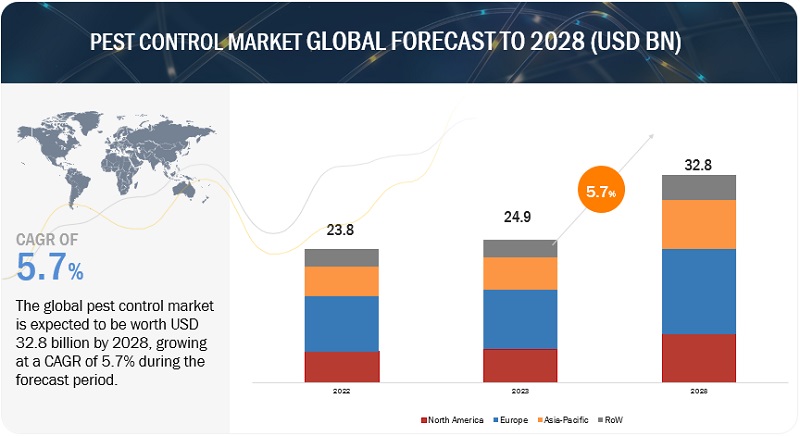The global pest control market is projected to reach $32.8 billion by 2028, growing from an estimated $24.9 billion in 2023, at a compound annual growth rate (CAGR) of 5.7%. Several key factors are driving the rising demand for pest control products and services worldwide. Increasing awareness of the health risks associated with pests and the diseases they spread is motivating both individuals and businesses to focus on pest prevention and management. This growing concern for health and hygiene is fueling the demand for pest control services. Additionally, advancements in pest control technologies and techniques have enhanced the effectiveness, precision, and sustainability of treatments, making them more appealing to consumers.

Urbanization and Population Growth: Rapid urban expansion and increased human populations are contributing to higher demand for pest control solutions in both residential and commercial sectors.
Health and Hygiene Concerns: Growing concerns about diseases spread by pests (e.g., mosquitoes transmitting malaria, rodents spreading hantavirus) are driving demand for pest management services and products.
Agricultural Sector: The increasing need for pest control in agriculture, to prevent crop damage and ensure food security, is a significant factor in the market’s growth.
Pest Resistance and Innovation: The development of new, more effective chemicals, as well as innovative technologies like integrated pest management (IPM), biological control methods, and eco-friendly products, is expanding market opportunities.
Regulations and Legislation: Stricter regulations on the use of certain chemicals and the growing preference for organic and non-toxic solutions are influencing the market toward more sustainable pest control practices.
Green and Organic Pest Control: The demand for eco-friendly, organic pest control products has surged, driven by consumer preferences for non-toxic and sustainable alternatives.
Technological Advancements: The use of technology in pest control, such as drones, AI, and automated pest monitoring systems, is revolutionizing the industry by increasing efficiency and effectiveness.
Integrated Pest Management (IPM): More businesses and homeowners are adopting IPM practices, which combine various control methods (biological, cultural, physical, and chemical) for sustainable pest management.
Smart Pest Control Solutions: The rise of smart pest control devices, such as ultrasonic repellents, smart traps, and app-controlled systems, is creating new opportunities in both residential and commercial pest control.
Download PDF Brochure: https://www.marketsandmarkets.com/pdfdownloadNew.asp?id=144665518
In terms of application methods, sprays are expected to dominate the market in terms of value during the forecast period.
Sprays are widely used for applying pest control solutions in controlled amounts to various surfaces and areas. This method ensures even distribution, allowing access to hard-to-reach places that may not be accessible using other methods. Spraying is ideal for both indoor and outdoor pest control applications, covering a broad range of scenarios. Furthermore, innovations in spray technology have led to more targeted, eco-friendly formulations that reduce the impact on non-target species and the environment.
In the pest type segment, insects are projected to hold the largest market share during the forecast period.
The demand for pest control targeting insect pests is growing steadily due to several factors that emphasize the need for effective management. Insects pose a significant risk to public health and property, prompting individuals, businesses, and governments to seek professional pest control solutions. With rising global populations, increased urbanization, and shifting climate patterns, the environments conducive to insect infestations are expanding. Insects, such as those that transmit diseases like Zika virus and malaria, make pest control efforts essential to public health. As awareness of the negative impacts of insect pests on human health, the economy, and the environment increases, so does the need for targeted pest control strategies.
Make an Inquiry: https://www.marketsandmarkets.com/Enquiry_Before_BuyingNew.asp?id=144665518
North America is expected to capture the largest market share during the forecast period.
The North American pest control market is expanding due to the growing applications in residential, commercial, livestock, and industrial sectors, such as food and pharmaceuticals. The region’s market is benefiting from a combination of factors, including the presence of numerous pest control companies—both large and local—that meet the rising demand for pest management services. Strict regulations in industries like food safety and hospitality are further driving the market’s growth. Moreover, the development of innovative pest control technologies, such as eco-friendly solutions and integrated pest management approaches, is appealing to environmentally conscious consumers.
Key players in the market include Bayer AG (Germany), Corteva Agriscience (US), BASF SE (Germany), Sumitomo Chemical Co. Ltd. (Japan), Syngenta AG (Switzerland), Rentokil Initial plc (UK), Anticimex (Sweden), Rollins, Inc. (US), ATGC Biotech Pvt Ltd. (India), Ecolab Inc. (US), FMC Corporation (US), De Sangosse (France), Bell Laboratories (US), PelGar International (UK), and Fort Products Limited (UK). Companies are focusing on expanding their production capabilities by entering partnerships, launching new products, and expanding into emerging markets. Key strategies include R&D-driven product innovations, geographical expansion to tap emerging economies, and strategic acquisitions to strengthen their market presence and control over the supply chain.

